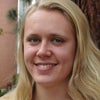 |
Undergraduate researcher:
Julia Lazzari-Dean Major: Chemistry Year: Sophomore Student funding sources: Provost’s Undergraduate Research Fellowship and Women in Science and Engineering |
 |
Graduate student researcher:
Ian McFarlane |
 |
Adviser:
Moh El-Naggar |
As a research assistant in Moh El-Naggar’s lab, Julia Lazzari-Dean regularly prepares solutions filled with microbes, which she studies closely with her collaborator Ian McFarlane.
The clear liquid grows into a yellowish-orange mass overnight. What look like bottles of pulpy orange juice are actually containers of arsenic sulfide, and they could hold a key to creating new nanomaterials that do jobs not yet imagined, explained El-Naggar, assistant professor of physics.
El-Naggar’s lab looks at how charges move in biological systems and finds ways to harness and apply them. Lazzari-Dean and McFarlane’s study — McFarlane’s dissertation project — could potentially generate nanosized structures useful for constructing solar panels or other technologies.
“If it works like I think it could, we could make cheap solar material in a bucket,” McFarlane said.
The study’s interdisciplinary nature demands collaborations that bring together scientists with different backgrounds, El-Naggar said. “With Julia’s interest in chemistry and Ian’s in biophysics, they ask different questions, which is how you push this sort of project forward.”
Studying chemistry as an undergraduate, Lazzari-Dean says she’s benefiting from working with colleagues who have different areas and levels of expertise.
“With Ian, I learn how to do various procedures and we talk about what we’re doing at each step,” Lazzari-Dean said. “Professor El-Naggar is a wonderful adviser because he’s so involved. I have the benefit of regular group meetings with him and one-on-one meetings in which I get to talk more about what the research means and where it’s going.”
In March, Lazzari-Dean and McFarlane presented findings from their study at the 2012 national meeting of the American Chemical Society in San Diego, Calif. Lazzari-Dean also presented her work to date in Spring 2011 and Spring 2012 at USC’s Undergraduate Symposium for Creative and Scholarly Work.
“Every time I present, I get more excited about my research,” Lazzari-Dean said. “It’s always really interesting to hear what kind of questions people ask.”
Return to Scholarly Symbiosis >
Read more articles from the Spring/Summer 2012 issue of USC Dornsife Magazine